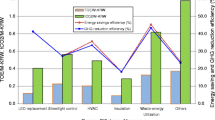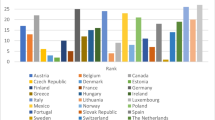Abstract
Consumer policy approaches regarding green products and solutions can be differentiated by their main focus. “Green positioning” is basically targeted at environmentally aware consumers, while “efficiency-focused positioning” concentrates on the efficiency gain of the product or solution, targeting the whole society, regardless of consumers' environmental awareness. The paper argues that the scope and total environmental benefit can be increased if green products or solutions are promoted in different ways, not only as “green” but also based on other arguments (like cost-efficiency, return on investment, etc.). The paper suggests a model for improving the efficiency of greenhouse gas (GHG)-related consumer policy. Based on the marginal social cost curve and the marginal private cost curve, different (green, yellow, and red) zones of action are identified. GHG mitigation options chosen from those zones are then evaluated with the help of profiling method, addressing the barriers to implementation. Profiling may help design an implementation strategy for the selected options and make consumer policy more effective and acceptable for mass market. Case study results show three different ways of positioning of GHG-related consumer policy in Hungary from 2000 and give practical examples of profiling, based on the latest marginal social cost curve and the contemporary energy saving policy of the state regarding the residential sector.







Similar content being viewed by others
References
Ajzen, I. (1985). From intentions to actions: A theory of planned behavior. In J. Kuhl & J. Beckman (Eds.), Action control: From cognition to behavior (pp. 11–39). Heidelberg: Springer.
Akaah, I. P., & Korgaonkar, P. K. (1988). A conjoint investigation of the relative importance of risk relievers in direct marketing. Journal of Advertising Research, 28(4), 38–44.
Arbuthnott, K. D. (2009). Education for sustainable development beyond attitude change. International Journal of Sustainability in Higher Education, 10, 152–163.
Baden, S., Fairey, P., Waide, P., de T'serclaes, P., & Lautsen, J. (2006). Hurdling financial barriers to low energy buildings: Experiences from the USA and Europe on financial incentives and monetizing building energy savings in private investment decisions. Proceedings of 2006 ACEEE Summer Study of Energy Efficiency in Buildings. Washington: American Council for an Energy Efficient Economy.
Behr, R. L., & Iyengar, S. (1985). Television news, real world cues, and changes in the public agenda. Public Opinion Quarterly, 49, 38–57.
Bertoldi, P., & Bogdan, A. (2006a). Residential lighting consumption and saving potential in the enlarged EU. European Commission Directorate–General Joint Research Centre Institute for Environment and Sustainability.
Bertoldi, P., & Bogdan, A. (2006b). Electricity consumption and efficiency trends in the enlarged European Union—Status report 2006. European Commission Directorate–General Joint Research Centre Institute for Environment and Sustainability.
Bonaiuto, M., Breakwell, G. M., & Cano, I. (1996). Identity processes and environmental threat: The effects of nationalism and local identity upon perception of beach pollution. Journal of Community and Applied Social Psychology, 6, 157–175.
Burgess, J., Bedford, T., Hobson, G., Davies, G., & Harrison, C. M. (2003). (Un)sustainable consumption. In F. Berkhout, M. Leach, & I. Scoones (Eds.), Negotiating environmental change: New perspectives from social science (pp. 261–293). Cheltenham: Edward Elgar Publishing Ltd.
CEN Technical Committee 250 (2010). Eurocodes. http://eurocodes.jrc.ec.europa.eu/.
Crane, A., & Peattie, K. (1999). Has green marketing failed…or has it never really tried? Conference Proceedings of the 1999 Business Strategy and the Environment Conference, 16th–17th September. Leeds, UK: University of Leeds.
Creyts, Y., Derkach, A., Nyquist, S., Ostrowski, K., & Stephenson, J. (2007). U.S. greenhouse gas abatement mapping initiative. Washington, DC: McKinsey & Company.
Csutora, M., & Zilahy, G. (1998). Economic analysis of greenhouse gas mitigation options in Hungary. Ph.D. Conference. Budapest: Budapest University of Economic Sciences.
Davies, J., Foxall, G. R., & Pallister, J. (2002). Beyond the intention-behaviour mythology: An integrated model of recycling. Marketing theory, 2, 29–113.
Dowling, G. R., & Staelin, R. (1994). A model of perceived risk and intended risk-handling activity. Journal of Consumer Research, 21, 119–134.
Ellen, P. S., Wiener, J. L., & Cobb-Walgren, C. (1991). The role of perceived consumer effectiveness in motivating environmentally conscious behaviors. Journal of Public Policy & Marketing, 10, 102–117.
European Commission. (2005). Attitudes of European citizens towards the environment, Special Eurobarometer 217. Brussels: European Commission.
European Commission. (2008). Attitudes of European citizens towards the environment, Special Eurobarometer 295. Brussels: European Commission.
European Commission. (2009). Energy policy factsheets for countries. Available at: http://ec.europa.eu/energy/energy_policy/doc/factsheets/country/hu/mix_hu_hu.pdf.
European Commission Joint Research Centre. (2009). PV status report: Research, solar cell production and market implementation of photovoltaics. Available at: http://re.jrc.ec.europa.eu/refsys/pdf/PV-Report2009.pdf.
Featherman, M. S., & Pavlou, P. A. (2003). Predicting e-services adoption: A perceived risk facets perspective. International Journal of Human Computer Studies, 59, 451–474.
Fliegenschnee, M., & Schelakovsky, M. (1998). Umweltpsychologie und Umweltbildung: Einführung aus humanökologischer Sicht. Wien: Facultas Universitäts Verlag.
GAP (Global Action Plan). (2008). EcoTeams evaluation report. Available at: http://www.globalactionplan.org.uk/upload/resource/GAP%20EcoTeams%20Evaluation%20Report%20June%2020081.pdf.
Government Decree of 1107/1999 (08.10) of the Hungarian Government. (1999). Magyar Közlöny 99/89, Budapest.
Hines, J. M., Hungerford, H. M., & Tomera, A. N. (1986). Analysis and synthesis of research on responsible pro-environmental behavior: A meta-analysis. The Journal of Environmental Education, 18(2), 1–8.
Hinostroza, M., Cheng, C., Zhu, X., Fenhann, J., Figueres, C., & Avendano, F. (2007). Potentials and barriers for end-use energy efficiency under programmatic CDM. Working Paper No. 3, CD4CDM Working Paper Series. Roskilde: UNEP Risø Centre on Energy, Climate and Sustainable Development. Available at: http://www.cd4cdm.org/Publications/pCDM&EE.pdf.
Hockerts, K., & Wüstenhagen, R. (2009). Greening Goliaths versus emerging Davids—Theorizing about the role of incumbents and new entrants in sustainable entrepreneurship. CBS Working Paper Series. CBS Center for Corporate Social Responsibility. Available at: http://openarchive.cbs.dk/bitstream/handle/10398/7122/wp%20cbscsr%202009-1.pdf?sequence=3.
Hofmeister-Tóth, Á., Kelemen, K., & Piskóti M. (2010). Changes in consumer behavior patterns in the light of sustainability. Conference Proceedings of Business and Economics Society International 2009 Conference, 15–19 July, Athen, pp 51–61.
IPCC. (1997). Workshop on mitigation and adaptation cost assessment. Denmark: IPCC.
Jaeger, C., Dürrenberger, G., Kastenholz, H., & Truffer, B. (1993). Determinants of environmental action with regard to climate change. Climate Change, 23, 193–211.
Jakob, M. (2006). Marginal costs and co-benefits of energy efficiency investments. The case of the Swiss residential sector. Energy Policy, 34, 172–187.
Jakob, M. (2007). The drivers of and barriers to energy efficiency in renovation decisions of single-family home-owners. CEPE Working Paper Series 07-56. Zürich: CEPE Center for Energy Policy and Economics, ETH.
Kollmuss, A., & Agyeman, J. (2002). Mind the gap: Why do people act environmentally and what are the barriers to pro-environmental behaviour? Environmental Education Research, 8, 239–260.
KSH. (2005). Housing conditions at the turn of the century. Budapest: KSH.
Labouze, E., Monier, V., Le Guern, Y., & Puyou, B. (2003). Study on environmental effects related to the lifecycle of products and services. Final Report version 2. Paris, France: European Commission, Directorate General Environment, Directorate A—Sustainable Development and Policy Support, BIO Intelligence Service/O2 France.
Marjainé Szerényi, Z., Zsóka, Á., & Széchy, A. (2009). Environmental education and pro-environmental consumer behaviour—Results of a university survey. Joint Actions on Climate Change Conference, 8–10 June, 2009, Aalborg, Denmark. Available at: http://gin.confex.com/gin/2009/webprogram/Paper2619.html.
Mishan, E. J., & Quah, E. (2007). Cost benefit analysis (5th ed.). London: Routledge.
Moll, H. C., Noorma, K., Kok, R., Engström, R., Throne-Holst, H., & Clark, C. (2006). Pursuing more sustainable consumption by analysing household metabolism in European countries and cities. In T. Jackson (Ed.), The Earthscan reader in sustainable consumption (pp. 67–87). UK: Earthscan.
Nässén, J., & Holmberg, J. (2009). Quantifying the rebound effects of energy efficiency improvements and energy conserving behaviour in Sweden. Energy Efficiency, 2, 221–231.
Nemcsicsné Zsóka, Á. (2005). Consistency and gaps in pro-environmental organisational behaviour. Ph.D. dissertation. Budapest: Corvinus University of Budapest.
NEP. (2009). National Energy Saving Programme. Available in Hungarian at: http://eupalyazatiportal.hu/nemzeti_energiatakarekossagi_program_2009/.
Novikova, A., & Ürge-Vorsatz, D. (2007). Carbon dioxide mitigation potential in the Hungarian residential sector. Report on behalf of the Ministry of Environment and Water of the Republic of Hungary. Available at: http://3csep.ceu.hu/projects/carbon-dioxide-mitigation-potential-in-the-hungarian-residential-sector.
Paavola, J. (2007). Institutions and environmental governance: A reconceptualization. Ecological Economics, 63, 93–103.
Peattie, K. (1999). In M. Charter & M. Polonsky (Eds.), Rethinking marketing: Shifting to a greener paradigm. In: Greener marketing. Sheffield: Greenleaf Publishing Ltd.
Reinhard, H., & Biermayr, P. (2000). The rebound effect for space heating. Empirical evidence from Austria. Energy Policy, 38, 403–410.
Robins, N., & Roberts, S. (2006). Making sense of sustainable consumption. In T. Jackson (Ed.), The Earthscan reader in sustainable consumption (pp. 39–50). UK: Earthscan.
Roselius, T. (1971). Consumer rankings of risk reduction methods. Journal of Marketing, 35(1), 56–61.
Rubik, F., Scholl, G., Biedenkopf, K., Kalimo, H., Mohaupt, F., Söebech, Ó., et al. (2009). Innovative approaches in European sustainable consumption policies. Berlin: Schriftenreihe des IÖW 192/09.
Shove, E. (2003). Comfort, cleanliness and convenience: The social organization of normality. Oxford: Berg Publisher.
Shove, E., Watson, M., Hand, M., & Ingram, J. (2007). The design of everyday life, cultures of consumption series. USA: Berg Publishers.
Slovic, P. (1987). Perception of risk. Science, 236, 280–285.
Slovic, P., & Weber, E. U. (2002). Perception of risk posed by extreme events. The Conference on Risk Management Strategies in an Uncertain World, held in 12–13 April, 2002, Palisades, New York, pp 1–21.
Southerton, D., Chappells, H., & Van Vliet, B. (Eds.). (2004). Sustainable consumption: The implications of changing infrastructures of provision. Cheltenham: Edward Elgar.
Spaargaren, G. (2000). Lifestyles, consumption and the environment: The ecological modernisation of domestic consumption. In A. P. J. Mol & D. A. Sonnenfeld (Eds.), Ecological modernisation around the world: Perspectives and critical debates. London: Frank Cass.
Spaargaren, G. (2003). Sustainable consumption: A theoretical and environmental policy perspective. Society & Natural Resources, 16, 687–701.
Spaargaren, G., & Martens, S. (2005). Globalisation and the role of citizen-consumers in environmental politics. In F. Vijen, K. Zooteman, & J. Pieters (Eds.), A handbook of globalisation and environmental policy: National government interventions in a global arena. Cheltenham: Edward Elgar.
Stern, P. C. (2000). Toward a coherent theory of environmentally significant behaviour. Journal of Social Issues, 56, 407–424.
Stern, N. (2008). The economics of climate change. The American Economic Review, 98, 1–37.
Thøgersen, J. (2005). How may consumer policy empower consumers for sustainable lifestyles? Journal of Consumer Policy, 28, 143–178.
Thøgersen, J., & Crompton, T. (2009). Simple and painless? The limitations of spillover in environmental campaigning. Journal of Consumer Policy, 32, 141–163.
Tukker, A., & Jansen, B. (2006). Environmental impacts of products. A detailed review of studies. Journal of Industrial Ecology, 10(3), 159–182.
Ürge-Vorsatz, D., & Füle, M. (1999). Economics of greenhouse gas limitations. Hungary Country Study. Denmark: UNEP Collaborating Centre on Energy and Environment and Riso National Laboratory.
van Raaij, W., & Verhallen, T. (1983). A behavioral model of residential energy use. Journal of Economic Psychology, 3(1), 39–63.
Weidema, B. P., Suh, S., & Notten, P. (2006). Setting priorities within product-oriented environmental policy: The Danish perspectives. Journal of Industrial Ecology, 10, 73–87.
Wesselink, B., & Deng, I. (2009). Sectoral emission reduction potentials and economic costs for climate change. London: ECOFYS.
Widegren, O. (1998). The new environmental paradigm and personal norms. Environment and Behavior, 30, 75–101.
World Research Institute (2010). Global climate trends 2005. Available at: http://earthtrends.wri.org/pdf_library/data_tables/cli5_2005.pdf.
Wüstenhagen, R. (1998). Greening Goliaths vs. multiplying Davids, Pfade einer Coevolution ökologischer Massenmärkte und nachhaltiger Nischen. St. Gallen: IWÖ-HSG.
Zilahy, G. (2004). Organisational factors determining the implementation of cleaner production measures in the corporate sector. Journal of Cleaner Production, 12(4), 311–319.
Zilahy, G., Nemcsicsné Zsóka, Á., Szeszler, Á., Ürge-Vorsatz, D., Markandya, A., & Hunt, A. (2000). The indirect costs and benefits of greenhouse gas limitation: Hungary case study. Handbook Reports. Denmark: UNEP Collaborating Centre on Energy and Environment and Riso National Laboratory.
Acknowledgement
Our research activity has been supported by the Norwegian Financial Mechanism.
Author information
Authors and Affiliations
Corresponding author
Rights and permissions
About this article
Cite this article
Csutora, M., Zsóka, Á. Maximizing the Efficiency of Greenhouse Gas Related Consumer Policy. J Consum Policy 34, 67–90 (2011). https://doi.org/10.1007/s10603-010-9147-0
Received:
Accepted:
Published:
Issue Date:
DOI: https://doi.org/10.1007/s10603-010-9147-0




